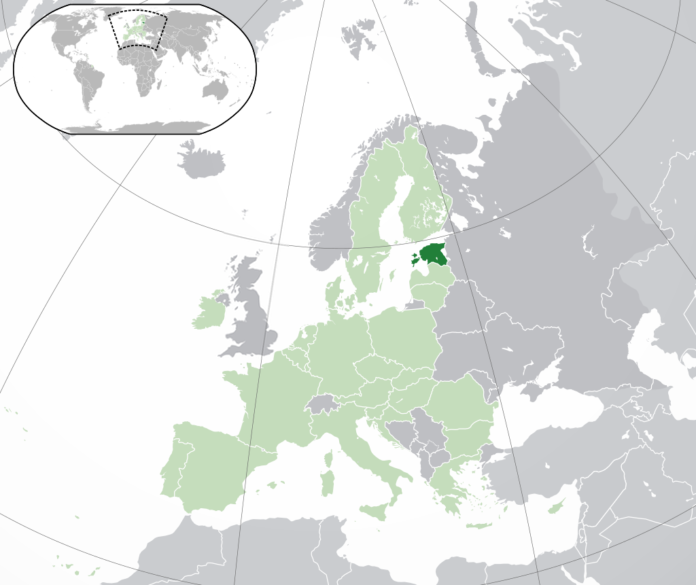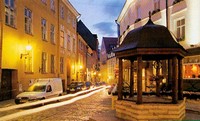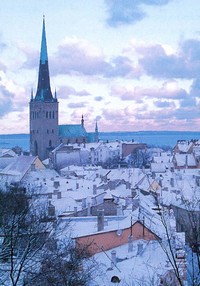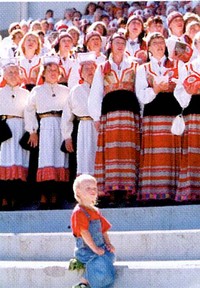Receive our newsletter
Your e-mail address is only used to send you our newsletter and information about the activities of Strasbourg Europe. You can always use the unsubscribe link included in the newsletter.


 After centuries of successive invasions and annexations by its neighbours, it was in the 19th century that a true sense of Estonian national identity began to emerge.
After centuries of successive invasions and annexations by its neighbours, it was in the 19th century that a true sense of Estonian national identity began to emerge.
Town Hall, Tallinn © Entreprise Estonia


 In the heart of Tallinn’s old town stands the majestic Saint Olaf Cathedral, a prestigious architectural treasure of Europe. The first written mention of this monument dates back to 1267. It was the most impressive Gothic church in Europe during the Middle Ages. At that time, its height of 124 m made it the highest church in Europe. Following a fire in 1433, the church was restored. This unique architectural masterpiece symbolises the glory of this city during the Middle Ages, a city which was at the peak of its influence from the 14th to the 16th century. At the beginning of the 16th century, St Olaf became the highest monument in the world with a spire reaching 159 m in height. According to legend, Olaf was the name of the man who built the church. Olaf struck up a deal with the nobles of Tallinn: either he would succeed in keeping his identity a secret and would then be paid for the construction of the building, or else his name would be discovered in which case he would not be paid. Following the discovery of his name, the people of the town called him while he was finishing the bell tower. Surprised, Olaf fell from the tower. At the spot where he fell, visitors can still see a snake and a toad petrified in the stone. In 1991, the KGB used the pointed tower of the cathedral as a radio transmitter.
In the heart of Tallinn’s old town stands the majestic Saint Olaf Cathedral, a prestigious architectural treasure of Europe. The first written mention of this monument dates back to 1267. It was the most impressive Gothic church in Europe during the Middle Ages. At that time, its height of 124 m made it the highest church in Europe. Following a fire in 1433, the church was restored. This unique architectural masterpiece symbolises the glory of this city during the Middle Ages, a city which was at the peak of its influence from the 14th to the 16th century. At the beginning of the 16th century, St Olaf became the highest monument in the world with a spire reaching 159 m in height. According to legend, Olaf was the name of the man who built the church. Olaf struck up a deal with the nobles of Tallinn: either he would succeed in keeping his identity a secret and would then be paid for the construction of the building, or else his name would be discovered in which case he would not be paid. Following the discovery of his name, the people of the town called him while he was finishing the bell tower. Surprised, Olaf fell from the tower. At the spot where he fell, visitors can still see a snake and a toad petrified in the stone. In 1991, the KGB used the pointed tower of the cathedral as a radio transmitter.
Saint-Olaf’s Cathedral © Entreprise Estonia
 Singing is an important tradition in Estonia. The Museum of Estonian Literature includes more than 1.3 million pages of popular songs. Going beyond folklore, since the 19th century songs have strengthened the cohesion of the Estonian people and have enjoyed a position of real importance. It comes as no surprise, then, that during the struggle for independence in 1988, a third of the population came together to sing out their political aspirations in the Songs ground. This episode was symbolic of the singing revolution. This music-loving nation includes some great and internationally renowned conductors (Neeme Järvi and Eri Klas) and composers (Arvo Pärt and Erkki-Sven Tüür). In 2001, Estonia won the Eurovision song contest. A large variety of music, ranging from contemporary to medieval, from jazz to pop, and from folk to religious music attracts huge crowds. In 1869, the first pan-Estonian song festival was held in Tartu. This festival is now held every five years in Tallinn on a stage which can bring together up to 30 000 singers at the same time. It is said that during this festival “half of the Estonians sing and the other half listen”.
Singing is an important tradition in Estonia. The Museum of Estonian Literature includes more than 1.3 million pages of popular songs. Going beyond folklore, since the 19th century songs have strengthened the cohesion of the Estonian people and have enjoyed a position of real importance. It comes as no surprise, then, that during the struggle for independence in 1988, a third of the population came together to sing out their political aspirations in the Songs ground. This episode was symbolic of the singing revolution. This music-loving nation includes some great and internationally renowned conductors (Neeme Järvi and Eri Klas) and composers (Arvo Pärt and Erkki-Sven Tüür). In 2001, Estonia won the Eurovision song contest. A large variety of music, ranging from contemporary to medieval, from jazz to pop, and from folk to religious music attracts huge crowds. In 1869, the first pan-Estonian song festival was held in Tartu. This festival is now held every five years in Tallinn on a stage which can bring together up to 30 000 singers at the same time. It is said that during this festival “half of the Estonians sing and the other half listen”.
© Entreprise Estonia
 Saint John’s Day
Saint John’s DayYour e-mail address is only used to send you our newsletter and information about the activities of Strasbourg Europe. You can always use the unsubscribe link included in the newsletter.
Information Center
on the European Institutions (CIIE)
Europe Direct Information Center
All rights reserved to the CIIE
Non-profit organization
Mailing address
1 allée Kastner
67000 Strasbourg
France
Visitors entrance
8 rue Boecklin
67000 Strasbourg
France
To provide the best experiences, we use technologies such as cookies to store and/or access device information. Consenting to these technologies will allow us to process data such as browsing behavior or unique IDs on this site. Failure to consent or withdrawing consent may adversely affect certain features and functions.
Europe Direct network
The CIIE team
Contact information and opening hours
Lieu d’Europe
The CIIE offices
Contact us
CIIE’s Documentation Centre & Publications
School presentations & Activities
Borrowing of learning material
Activities for the general public
Institutions of the European Union in Strasbourg
Institutions Under the Authority of the Council of Europe
Other European Organisations in Strasbourg
Sessions of the European institutions in Strasbourg
Visiting the institutions
Map of the European district of Strasbourg
Institutions in Strasbourg in photos
Discover artistic Europe
National holidays of the member states of the Council of Europe